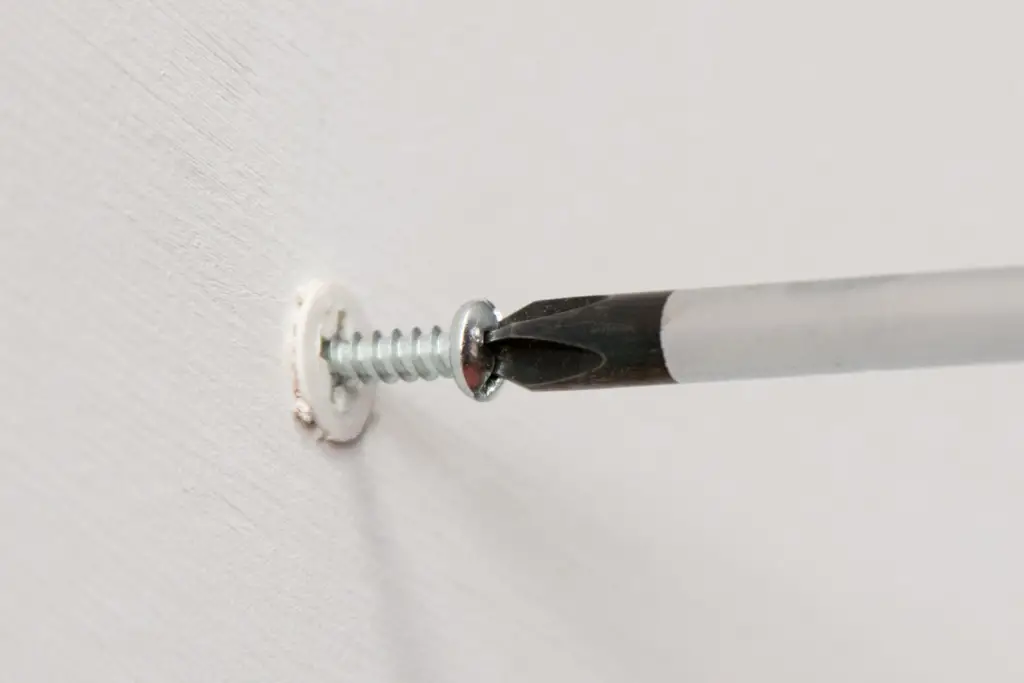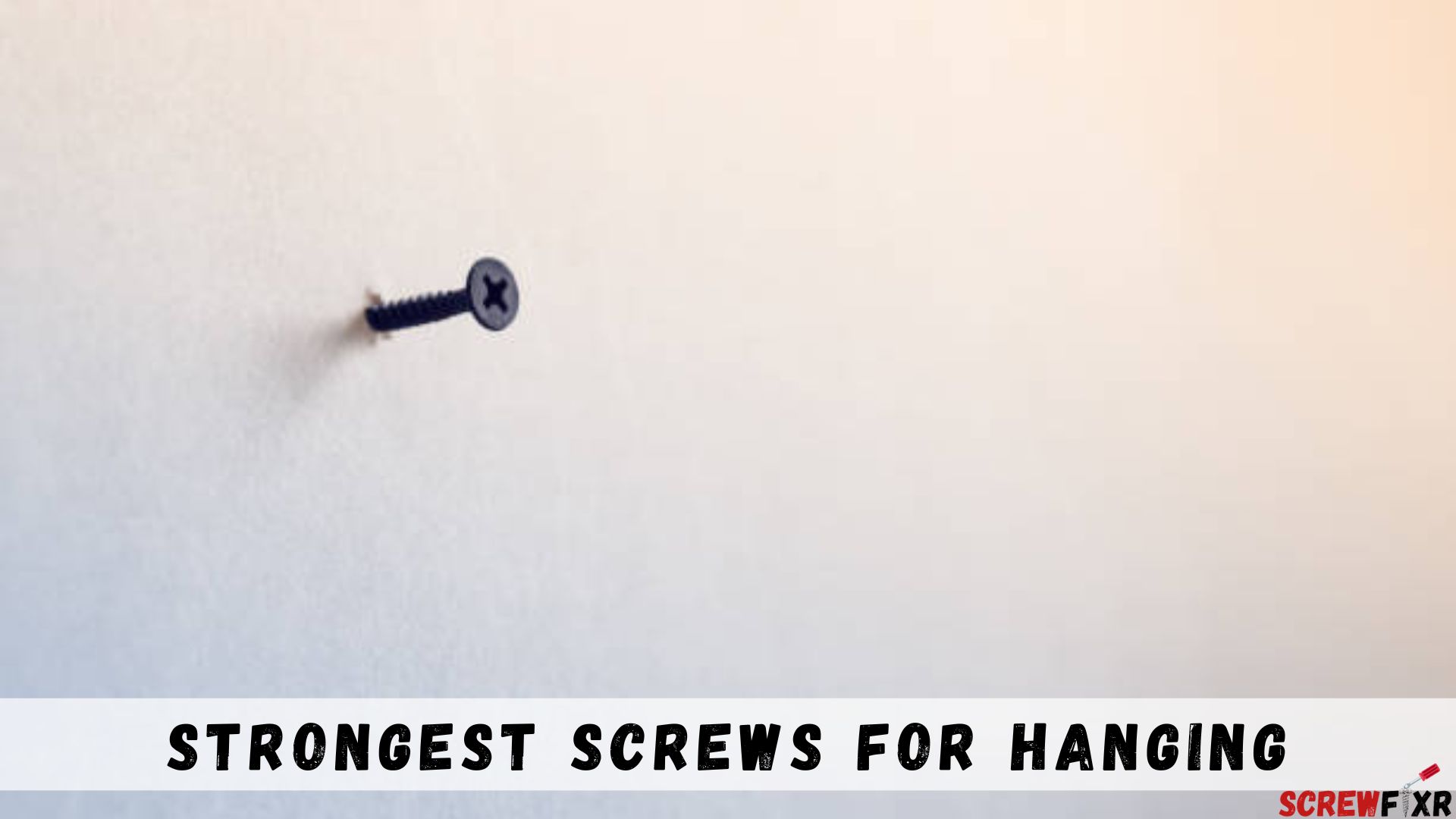Hanging artwork, shelves, or any decorative item can instantly transform a space. However, the key to a successful installation lies in choosing the right screws. Welcome to our comprehensive guide on the Strongest Screws for Hanging, where we’ll delve into the world of screws that can handle the weight and keep your precious possessions firmly on the wall.
Understanding Screw Strength

When it comes to hanging heavy objects securely, understanding the strength of different screws is essential. Screws come in various types, materials, and sizes, all of which can significantly impact their strength and performance.
Screw Material Composition
- Steel Screws
- Steel screws are among the most common and versatile choices for various applications. They are known for their strength and durability. These screws can be used in a wide range of projects, from hanging shelves to mounting artwork.
- Stainless Steel Screws
- Stainless steel screws are particularly resistant to corrosion and rust, making them ideal for outdoor and moisture-prone environments. They are often used for hanging objects in bathrooms or gardens.
- Brass Screws
- Brass screws offer an elegant and decorative option for hanging items. They are corrosion-resistant and suitable for both indoor and outdoor use. Brass screws are often chosen for hanging mirrors and frames.
Screw Thread Types
- Coarse Thread vs. Fine Thread
- Coarse-threaded screws have deeper threads and are better suited for fastening into softer materials like wood. They provide a strong grip and are less likely to strip.
- Fine-threaded screws have shallower threads and are designed for use in harder materials like metal or plastic. They offer a more secure hold of these materials.
- Self-Tapping Screws
- Self-tapping screws possess a unique design that enables them to form threads within the material as they are driven in. This feature makes them convenient for quick and easy installations.
Screw Head Types
- Phillips Head Screws
- Phillips head screws have a cross-shaped indentation on the head and require a Phillips screwdriver for installation. They are commonly used in various applications due to their versatility.
- Torx Head Screws
- Torx head screws feature a star-shaped pattern on the head and are known for their excellent resistance to cam-out (slipping). They are often used in high-torque applications.
- Hex Head Screws
- Hex head screws have a hexagonal-shaped head and are typically installed using a wrench or socket. They provide a secure grip and are commonly used in heavy-duty applications.
Screw Length and Diameter
- Impact of Length on Strength
- The length of a screw plays a crucial role in its strength. Longer screws can distribute the weight of a hung item over a larger area, reducing the risk of failure. However, excessively long screws can damage the underlying material.
- Choosing the Right Diameter
- The diameter of a screw also affects its strength. Larger-diameter screws generally provide greater holding power. It’s essential to match the screw diameter to the size of the anchors or holes you plan to use for installation.
Understanding these aspects of screw strength is the foundation for selecting the right screws for your hanging projects. In the next sections, we’ll explore the strongest screws for specific applications and provide installation tips for maximum security.
Strongest Screws for Hanging

Selecting the appropriate screws and anchors for your hanging project is crucial, as different materials require different solutions to ensure a secure and lasting installation. Below, we’ll explore the considerations for various materials:
Hanging on Drywall
Hanging objects on drywall can be challenging because it’s not as sturdy as other materials. However, with the right screws and anchors, you can achieve a secure hold.
- Drywall Anchors
- Utilize drywall anchors to distribute the load evenly and prevent damage to the drywall.
- Choose from options like plastic expansion anchors, winged anchors, or toggle bolts based on the weight of the item you’re hanging.
Hanging on Concrete and Masonry
Concrete and masonry surfaces are exceptionally robust, but they require specialized screws and tools for successful installations.
- Concrete Anchors
- Opt for concrete anchors such as sleeve anchors or wedge anchors designed to penetrate and grip concrete or masonry effectively.
- Ensure you have the correct drill bits and tools for drilling into these hard materials.
Hanging on Wood and Studs
Wooden surfaces and wall studs provide a solid foundation for hanging heavy items. Choosing the right screws and locating studs are key.
- Wood Screws
- When working with wood or studs, use wood screws or structural screws with coarse threads designed to grip wood securely.
- Locate and mark the position of studs using a stud finder for maximum strength.
Hanging on Tile and Ceramic Surfaces
Hanging on tile and ceramic surfaces requires extra care to avoid damaging the tiles.
- Tile Anchors
- For tile and ceramic surfaces, employ specially designed tile anchors or masonry screws.
- Pre-drilling pilot holes is essential to prevent tile cracking during installation.
By taking into account the material you’re working with, you can select the most suitable screws and anchors that match the strength and composition of the surface.
The Strongest Screws for Various Applications

When it comes to hanging heavy items securely, selecting the right screws is paramount. The strength of the screws you choose can make a significant difference in the safety and longevity of your installation. Below, we’ll explore the strongest screws for different applications:
High-Load Drywall Anchors
- Plastic Expansion Anchors
- Ideal for moderately heavy items like shelves and small mirrors.
- These anchors expand behind the drywall to distribute the load.
- Winged Anchors
- Suitable for heavier items like large mirrors and wall cabinets.
- The wings on these anchors provide excellent stability and load-bearing capacity.
- Toggle Bolts
- Perfect for very heavy items such as large TVs and heavy artwork.
- Toggle bolts spread the load across a large area behind the drywall.
Heavy-Duty Screws for Wood and Studs
- Lag Screws
- Excellent for attaching items to wooden surfaces and studs.
- These large screws offer superior holding power and are often used in carpentry and construction.
- Structural Screws
- Ideal for demanding structural applications and attaching heavy items to wooden framing.
- They have high shear and tensile strength.
Concrete Anchors for Masonry
- Sleeve Anchors
- Suitable for medium to heavy loads in concrete and masonry.
- Sleeve anchors expand within the material for a secure hold.
- Wedge Anchors
- Designed for high-stress applications in concrete and masonry.
- Wedge anchors provide exceptional load-bearing capacity.
Specialty Screws for Unique Hanging Needs
- Ceiling Hooks
- Used for hanging plants, light fixtures, or decorative items from ceilings.
- Choose heavy-duty hooks with appropriate weight ratings.
- Masonry Screws
- Designed for securing items to brick or stone surfaces.
- They offer a reliable hold without the need for anchors.
- Cabinet Screws
- Specifically designed for attaching cabinets securely to walls.
- Cabinet screws are engineered to withstand the weight of kitchen or bathroom cabinets.
Selecting the strongest screws for your hanging project is crucial to ensure safety and stability. Always consider the weight of the item you plan to hang and the material of the wall or surface. When in doubt, opt for screws with higher load-bearing capacities to provide an extra margin of safety.
Installation Tips for Maximum Strength
To ensure the strongest and most secure installation when hanging heavy objects, it’s essential to follow best practices and guidelines. Here are some valuable tips to maximize the strength and safety of your installations:
A. Locating Wall Studs and Ceiling Joists
- Using a Stud Finder
- Invest in a high-quality stud finder to accurately locate wall studs or ceiling joists. These are the ideal anchor points for heavy installations.
- Measuring from Corners
- When hanging objects on walls, measure from corners or existing fixtures to ensure proper alignment and support.
Pre-Drilling Holes
- Choosing the Right Drill Bit
- Select the appropriate drill bit size for the screws or anchors you’re using. The hole should be slightly smaller than the screw or anchor diameter.
- Depth Matters
- Drill holes to the correct depth to accommodate the full length of the screw or anchor, ensuring a snug fit.
Using Anchors Properly
- Follow Manufacturer Instructions
- Always adhere to the manufacturer’s instructions when using anchors. This includes recommended weight limits and installation techniques.
- Proper Anchor Selection
- Match the anchor type to the wall material. Use plastic expansion anchors for drywall and specialized concrete anchors for masonry.
Calculating Load Capacity
- Know the Weight
- Determine the weight of the object you’re hanging, including any additional stress it may endure (e.g., dynamic forces or vibrations).
- Consider Safety Margin
- Choose screws and anchors with load capacities well above the calculated weight to provide a safety margin.
Avoiding Common Installation Mistakes
- Overloading
- Never exceed the weight capacity of your chosen screws or anchors. Distribute heavy loads across multiple anchors if necessary.
- Misalignment
- Ensure that your installation is level and properly aligned. Misalignment can lead to undue stress on screws and anchors.
- Skipping Pilot Holes
- Always pre-drill pilot holes, especially when working with hardwoods or dense materials. This reduces the risk of splitting the wood and ensures accurate placement.
- Tightening Too Much
- Use a torque-limiting screwdriver or drill to avoid overtightening screws, which can damage the anchor or material.
- Not Checking for Obstacles
- Before drilling, verify that there are no hidden electrical wires, plumbing, or other obstacles behind the wall or ceiling.
By following these installation tips diligently, you can significantly enhance the strength and reliability of your hanging projects. Proper preparation and attention to detail ensure that your installations remain safe and secure over time.
Frequently Asked Questions

How do I know which type of screw to use for a particular project?
Choosing the right screw depends on the material of your wall and the weight of the object you want to hang. For heavy items on drywall, use toggle bolts or anchors. For wooden walls, opt for wood screws, and for masonry, choose masonry screws.
Can I use regular screws for hanging?
While regular screws can work for lightweight items, it’s safer to use screws specifically designed for hanging, as they provide superior strength and stability.
How deep should I drill a hole before inserting a screw?
The hole’s depth should be slightly shorter than the screw’s length to ensure a snug fit. Use an anchor or toggle bolt for added security, following the manufacturer’s instructions.
Do I need any special tools for hanging with these screws?
For basic installations, a drill and screwdriver should suffice. However, some projects may require wall anchors or toggle bolts, which might require additional tools for proper installation.
Can I reuse these screws if I want to move my wall decor?
In most cases, screws can be reused if removed carefully. However, it’s a good practice to replace them with new ones if you plan to hang something else in the same spot.
What’s the weight capacity of these screws?
The weight capacity varies depending on the type and size of the screw. Always check the manufacturer’s specifications to ensure your chosen screws can handle the weight of your object.
Conclusion
Choosing the strongest screws for hanging is essential for the safety and longevity of your wall installations. Whether you’re a DIY enthusiast or a professional, understanding the different types of screws and their applications will ensure your decor remains securely in place.
So, the next time you embark on a decorating project, remember to select the right screws. Happy decorating!


